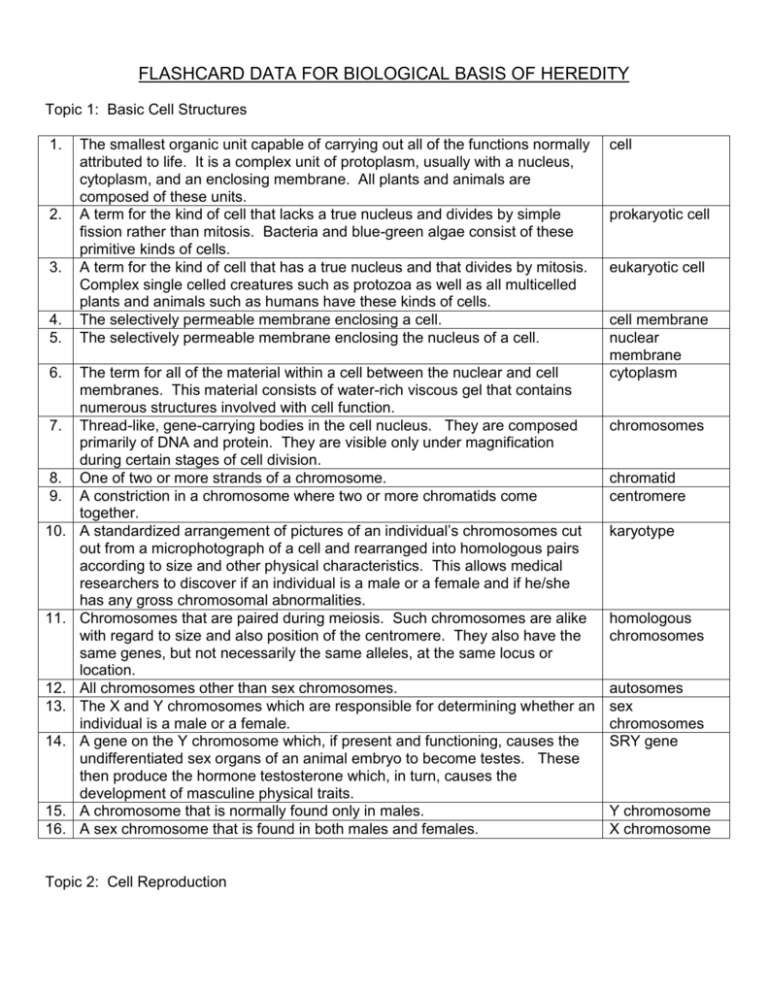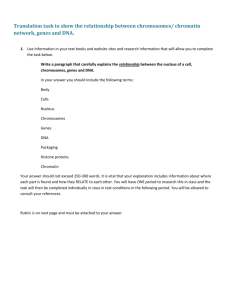
FLASHCARD DATA FOR BIOLOGICAL BASIS OF HEREDITY
Topic 1: Basic Cell Structures
1.
2.
3.
4.
5.
6.
7.
8.
9.
10.
11.
12.
13.
14.
15.
16.
The smallest organic unit capable of carrying out all of the functions normally
attributed to life. It is a complex unit of protoplasm, usually with a nucleus,
cytoplasm, and an enclosing membrane. All plants and animals are
composed of these units.
A term for the kind of cell that lacks a true nucleus and divides by simple
fission rather than mitosis. Bacteria and blue-green algae consist of these
primitive kinds of cells.
A term for the kind of cell that has a true nucleus and that divides by mitosis.
Complex single celled creatures such as protozoa as well as all multicelled
plants and animals such as humans have these kinds of cells.
The selectively permeable membrane enclosing a cell.
The selectively permeable membrane enclosing the nucleus of a cell.
The term for all of the material within a cell between the nuclear and cell
membranes. This material consists of water-rich viscous gel that contains
numerous structures involved with cell function.
Thread-like, gene-carrying bodies in the cell nucleus. They are composed
primarily of DNA and protein. They are visible only under magnification
during certain stages of cell division.
One of two or more strands of a chromosome.
A constriction in a chromosome where two or more chromatids come
together.
A standardized arrangement of pictures of an individual’s chromosomes cut
out from a microphotograph of a cell and rearranged into homologous pairs
according to size and other physical characteristics. This allows medical
researchers to discover if an individual is a male or a female and if he/she
has any gross chromosomal abnormalities.
Chromosomes that are paired during meiosis. Such chromosomes are alike
with regard to size and also position of the centromere. They also have the
same genes, but not necessarily the same alleles, at the same locus or
location.
All chromosomes other than sex chromosomes.
The X and Y chromosomes which are responsible for determining whether an
individual is a male or a female.
A gene on the Y chromosome which, if present and functioning, causes the
undifferentiated sex organs of an animal embryo to become testes. These
then produce the hormone testosterone which, in turn, causes the
development of masculine physical traits.
A chromosome that is normally found only in males.
A sex chromosome that is found in both males and females.
Topic 2: Cell Reproduction
cell
prokaryotic cell
eukaryotic cell
cell membrane
nuclear
membrane
cytoplasm
chromosomes
chromatid
centromere
karyotype
homologous
chromosomes
autosomes
sex
chromosomes
SRY gene
Y chromosome
X chromosome
1.
2.
3.
4.
5.
6.
7.
8.
9.
10.
11.
12.
13.
14.
15.
16.
17.
18.
19.
20.
The general term for the cells in your body that are not directly involved
with reproduction. Most cells in multicellular plants and animals are of this
type.
The general term for the specialized cells in your body that are created for
sexual reproduction. These cells are also called gametes.
The cell division process that occurs in somatic cells. One cell divides into
two offspring cells that are identical to each other in their chromosome
complement. Body tissues such as skin, hair, and muscle, are duplicated
by this process.
The general term for the cell division process in specialized tissues of
ovaries and testes which results in the production of sex cells. This
process involves two divisions and results in cells that contain only half the
number of chromosomes as somatic cells.
A female sex cell or gamete.
The place in a woman’s reproductive system where sex cells are produced
and stored.
A male sex cell or gamete.
The place in a man’s reproductive system where sex cells are produced.
The specific term for the meiosis process in males that produces sperm.
The specific term for the meiosis process in females that produces ova.
An immature female sex cell in humans and many other animals produced
before birth and stored in the ovaries. These cells complete the meiosis
process usually one by one after puberty when hormones trigger ovulation.
The term for the number of chromosomes in a normal somatic cell. This
number is 46 (23 pairs) for humans.
The term for the number of chromosomes in a normal sex cell. This
number is 23 for humans.
The kind of cell that is formed when a sperm and an ovum combine their
chromosomes at conception. It contains the full complement of
chromosomes (in humans 46) and has the potential of developing into an
entire organism. This kind of cell is also referred to as a "fertilized" ovum.
The term for individuals who have parts of both male and female sex
organs thereby making their gender somewhat ambiguous.
The release of a secondary oöcyte from an ovary to begin its path down
one of a woman’s fallopian tubes to the uterus in preparation for
conception. This process only occurs after puberty when hormones cause
a resumption of meiosis for one to several primary oöcytes each month.
The place in a woman’s reproductive system where conception usually
occurs.
Twins that are mostly identical genetically because they result from one
zygote splitting into two separate ones within a few days after conception.
Twins that share their mother's uterus during gestation but come from two
different eggs fertilized with different sperm. They are not genetically
identical.
An individual who came from two zygotes that fused together. If one of the
zygotes is male and the other female, the individual will most likely be a
hermaphrodite.
somatic cells
sex cells
mitosis
meiosis
ovum (plural ova)
ovaries
sperm
testes
spermatogenesis
oögenesis
oöcyte
diploid number
haploid number
zygote
hermaphrodite
ovulation
fallopian tubes
monozygotic or
identical
dizygotic or
fraternal
chimera or genetic
chimera
Topic 3: Recombination and Linkage
Topic 4: Sex-linked Genes
1.
2.
Genes that are on the same chromosome and subsequently are inherited
together as a package unless crossing-over separates them.
The exchange of genetic material (DNA) between homologous chromosomes at
the beginning of meiosis. This results in sperm and ova with greater genetic
diversity due to a recombination of genes. Specifically, a portion of a
chromosome is broken and reattached on another chromosome.
Genes that are linked together because they are carried by a sex chromosome.
crossing-over
The largest sex chromosome in humans. This chromosome is inherited by both
males and females.
The names for the two sex chromosomes of females.
sex-linked
genes
X-linked
genes
Y-linked
genes
X
chromosome
XX
The names for the two sex chromosomes of males.
XY
An X-linked genetically inherited recessive disease in which one or more of the
normal blood clotting factors is not produced. This results in prolonged bleeding
from even minor cuts and injuries. It most often afflicts males.
hemophilia
3.
Genes that are linked together because they are carried by an X chromosome.
4.
Genes that are linked together because they are carried by an Y chromosome.
5.
6.
linked genes
7.
8.
9.
Topic 5: Molecular Level of Genetics
1.
2.
3.
4.
5.
6.
7.
8.
The category of organic molecules that include sugars and starches.
The category of organic molecules that include fats, oils, and waxes.
A large chain-like molecule that is normally twisted and folded back on
itself in a complex pattern. Molecules of this type serve as structural
material for the body, gas transporters, hormones, antibodies,
neurotransmitters, and enzymes.
The term for a protein that causes or regulates specific chemical
reactions within cells.
A kind of organic molecule that is a building block of proteins. Proteins
are composed of different combinations of 20 different kinds of these
molecules assembled in chain-like molecules.
The largest kind of molecule in humans and other organisms. DNA and
RNA are types of this kind of molecule.
A large organic molecule that stores the genetic code for the synthesis
of proteins. It is composed of sugars, phosphates and bases arranged
in a double helix shape. Segments of this molecule correspond to
specific genes.
A type of nucleic acid that is found in both the nucleus and the
cytoplasm of cells. Unlike DNA, this molecule is single stranded.
Different forms of it play important roles in the synthesis of proteins.
carbohydrate
lipid
protein
enzyme
amino acid
nucleic acid
DNA
(deoxyribonucleic
acid)
RNA (ribonucleic
acid)
9.
The four chemical bases in DNA molecules.
10. The basic building block of nucleic acids. It consists of any one of four
specific chemical bases attached to a sugar and phosphate group.
11. A sequence of three nucleotides in a DNA or RNA molecule that codes
for a specific type of amino acid that will be used in the synthesis of a
protein.
12. The name for the twisted ladder shape that is characteristic of DNA
molecules.
13. DNA base pairs that code for proteins and, therefore, are part of genes.
Only 1.1-1.5% of DNA consists of these kinds of base pairs.
14. DNA base pairs that do not code for proteins and, therefore, are not part
of genes. These kinds of base pairs have been referred to as "junk"
DNA, however, it is now known that they perform important functions.
Some are subtle enhancers or suppressors of genes, while others act
as buffers against mutations.
15. Small rod-like structures in the cytoplasm that produce fuel for the cell in
the form of adenosine triphosphate (ATP). A small amount of DNA is
located in these structures. This DNA is normally inherited only from
mothers and is distinct from DNA that makes up the chromosomes.
16. The form of RNA that carries a copy of a specific sequence of genetic
information (a gene) from the DNA in the cell nucleus to the ribosomes
in the cytoplasm where it is translated in order to synthesize a protein.
This form of RNA is assembled on one sequence (one strand) of DNA
bases.
17. A form of RNA that binds to specific amino acid molecules and
transports them to the ribosomes for the assembly of proteins. This
form of RNA temporarily bonds with corresponding mRNA codons at the
ribosomes in this process of protein synthesis.
18. Small roughly spherical structures near the endoplasmic reticula in the
cytoplasm of cells. These structures are the sites where proteins are
assembled by the momentary bonding of mRNA and tRNA.
19. The process at the beginning of mitosis and meiosis by which a DNA
molecule is duplicated or copied. One DNA molecule becomes two
identical ones. This is accomplished by the DNA molecule unwinding
and unzipping along its base pairs so that both sides can be copied by
free nucleotides. This process is triggered and controlled by enzymes.
Copyright © 2007-2012 by Dennis O'Neil. All rights reserved.
guanine, cytosine,
adenine, and thymine
nucleotide
codon
double helix
exons
introns
Mitochondria
(singular
mitochondrion)
mRNA (messenger
RNA)
tRNA (transfer RNA)
ribosomes
DNA replication









